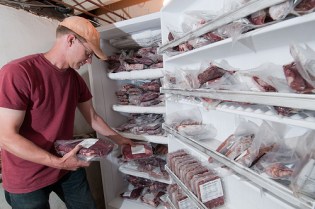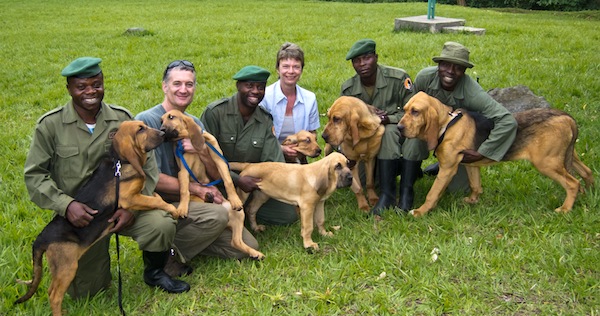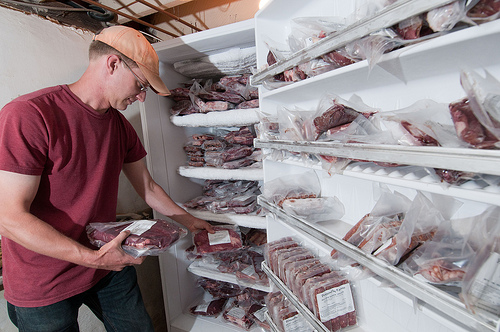
Local Food Hub in Virginia takes care of distribution for the small farms it works with. (Photo by USDA.)
Ask most small and mid-sized farmers who sell food to a local audience what they like least about their job and they will probably say marketing and distribution. Driving long hours to sit at farmers markets (or managing someone else who does) is always a risk that can result in unsold leftovers. And even when you have a guaranteed market — like in the case of community-supported agriculture (CSA) and restaurant sales — the effort involved diverts time and energy from the actual work of farming.
Enter food hubs. A key component of the USDA’s Know Your Farmer, Know Your Food initiative, food hubs operate on the simple principle that farmers, like everyone else, are stronger when they work together. Food hubs are networks that allow regional growers to collaborate on marketing and distribution. The term applies to a broad range of operations, from multi-farm CSAs to Craigslist-like virtual markets where buyers and producers can connect. But each model is motivated by the belief that individual farms can’t survive in a vacuum.
“When everybody was a farmer, there was all sorts of infrastructure to support family-scale farming, and that’s all gone,” said Amanda Oborne, director of FoodHub, an online resource that connects growers, buyers, and distributors in the western U.S. “Food hubs are a huge part of the answer to rebuilding that infrastructure.”
“Talking, getting together — that in and of itself is a new thing for a lot of growers,” said Dru Rivers, whose Full Belly Farm in California’s Capay Valley is part of the Capay Valley Farm Shop. “The food hub brings together this region, rather than [us farmers] competing against each other.”

Employees at the Local Food Hub. (Photo by USDA.)
Capay Valley Farm Shop partners with 26 institutions around the Bay Area (about 100 miles away from the valley), from schools to cafes to companies like Ideo and Adobe, to offer “farmshares,” CSA boxes containing not just one farm’s produce but an assortment of the best offerings from the shop’s network of 35 farms. Last year the farm shop started offering wholesale produce as well, selling to company kitchens and neighborhood markets.
“The collaboration allows everyone to market together, so there’s one truck that goes to the city, and one delivery route,” Rivers said. “Some of us are much better farmers than we are marketers, so [it’s] a tremendous help, and allows the farmers to focus on what they’re good at.”
Local Food Hub, in the Charlottesville, Va., area, concentrates solely on distributing wholesale produce to its 150 buyers, which include public schools, hospitals, and nursing homes, as well as restaurants and grocery stores. “We really try to focus on those big institutional markets that small farmers have been traditionally locked out of,” explained Emily Manley, Local Food Hub’s director of outreach and development.
Many of those institutions feel the customer demand for local food but don’t know how best to meet it. “If the purchasing manager [at a hospital] can call up Sysco and get all the tomatoes he needs, he doesn’t want to call up a bunch of different farmers and coordinate with each,” Manley explained. “We do all the logistics.”
Farmers tend to be risk-averse by necessity, and Manley likes being able to offer them a solid commitment. “We say, here’s where there’s opportunity; we’ll commit to buying this amount of squash from you every week. Just having that information is key to being more efficient and growing more food.”
By making regional distribution easier for farmers who usually have to compete with cheap produce trucked and shipped from afar, food hubs also pump dollars back into the local economy. Local Food Hub has invested over $1 million in direct farm purchases in its two and a half years of existence.
Beyond the direct economic benefits, connecting eaters with local growers helps cultivate a sense of regional pride and solidarity. “We have a real attachment to making sure our valley continues to have its rural, agricultural heritage,” Rivers said. “We want food to be recognized from a region, not just one farm.”

Bruce Johnson at Dragonfly Farm sells his pastured meat through the Fall Line Farms food hub. (Photo by USDA.)
Virtual hubs, like FoodHub, FarmsReach, and Local Dirt, offer a more interactive way for growers and eaters to connect, allowing them to specify exactly what they’re looking for, the same way apartment hunters can filter their Craigslist results by neighborhood, price, or number of bedrooms. “Our point really is to make it all transparent,” Oborne said.
Food hubs maintain the transparency that draws eaters to farmers markets and CSA programs, while ramping up the efficiency necessary to get fresh, local food to a wider audience. Thomas Nelson, one of the community members who founded the Capay Valley Farm Shop, describes food hubs as “the center of the new rural economy. Once you begin to put that infrastructure in place,” he adds, “it gives new farmers more confidence that they have the support they need to succeed.”
Which is why it’s great to see the USDA taking food hubs seriously, offering funding [PDF], doing research, and collaborating with groups like the National Good Food Network to provide webinars and other resources to help food hubs get off the ground. The local food supply won’t keep pace with demand unless new, young farmers feel that encouragement. Even veteran growers sense the tide turning.
“I’ve been farming here for 28 years,” Rivers said. “Having this new venture makes it exciting again.”



